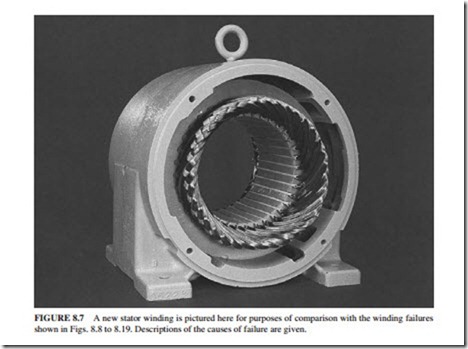REPAIR AND REFURBISHMENT OF AC INDUCTION MOTORS
The repair and refurbishment of an ac induction motor should include the following steps:
1. Perform a visual inspection to assess the general condition of the motor. Check for cracks, broken welds, and missing parts. Photographs are required in some cases prior to disassembly of the motor to document the motor construction and accessories.
2. Perform these tests on the stator windings and record the results:
● Insulation resistance (IR) and polarization index (PI)
● Winding resistances (terminal-to-terminal resistances)
3. Rotate the rotor manually, and check for any defects in the bearings and shaft.
4. Run the motor at no load. Measure and record the currents, vibration, bearing temper- atures, and temperature rises.
5. Measure and record the rotor end play (axial and radial movement of the rotor in the bearings).
6. Dismantle the motor and remove the rotor.
Stator Work
7. Clean the windings, using low-pressure steam, if they are contaminated with dust, oil, or grease.
8. Dry the stator in an oven at a temperature of 105°C (220°F) for a period of 6 h.
9. Take IR and PI tests. Note: Following steam cleaning and drying of the windings, the results of IR and PI tests should improve.
10. Inspect the motor cable insulation for cracks, overheating, and brittleness.
11. Inspect the stator insulation for cracks, brittleness, and puffiness.
12. Inspect the slot wedges and bracing system in the stator for looseness.
13. Inspect the laminations in the stator core for looseness, damage due to rotor rubbing, localized overheating, and blockage of the vent ducts.
8.20 CHAPTER EIGHT
14. If there are no defects in the core or windings of the stator, perform these tests on the stator windings and record the results:
● Insulation resistance and polarization index tests
● Terminal-to-terminal resistances (winding resistances)
● DC high-potential test
● Surge (impulse) test
Rotor Work
15. If there is a dust, grease, or oil contamination on the rotor, clean it with low-pressure steam.
16. Inspect the rotor laminations for looseness, cracks, and damage due to rubbing with the stator and localized overheating.
17. Inspect the rotor shaft fans of the motor for cracks. If there are signs of cracks, perform dye penetrant and ultraviolet light inspection.
18. Inspect the bars and end rings of the rotor for cracks, looseness, and localized over- heating. If there are signs of cracks, perform the manual rotation test as well as dye penetrant and ultraviolet light inspection.
19. Inspect the rotor shaft for cracks.
20. Mount the rotor on a lathe and measure the eccentricity of the shaft. The total indicated reading should be less than 0.0038 cm (0.0015 in).
Bearings
21. Inspect the bearings for cracks, wear, etc.
Oil and Water Heat Exchangers
If heat exchangers are used, perform the following steps:
22. Perform chemical cleaning of the heat exchanger, using a weak acid solution.
23. Inspect the heat exchanger for erosion and corrosion.
24. Perform a hydrostatic pressure test to confirm the integrity of the heat exchanger. The pressure of the water during the test should be 1.5 times the design pressure of the heat exchanger.
25. If there is evidence of corrosion or erosion, perform an eddy current inspection on the tubes of the heat exchanger. All tubes that experienced a reduction of more than 50 per- cent in the wall thickness should be plugged. If more than 10 percent of the tubes have experienced a reduction in wall thickness of more than 50 percent, consideration should be given to replace the heat exchanger.
Temperature Detectors
26. Perform a visual and a functional check for all resistance temperature detectors (RTDs) and thermocouples used in the winding or bearings of the motor.
Motor Repair
27. All defective components should be repaired or replaced.
28. Perform all the tests listed in either Table 8.3 (for 575-V motors) or Table 8.4 (for 4-kV motors). The results of the tests should meet the acceptance criteria before the motor can be reassembled.
Motor Rewind
If the windings of the motor have serious damage, the motor should be rewound.
Related posts:
Incoming search terms:
- endection repair
- how to repair induction motor
- fixing an induction motor
- Repairs maintenance of induction motor
- repairing and maintenance of induction motor
- repairing of induction motor
- repair induction motors
- is the induction motor repaired
- induction motor repairing
- induction motor repair
- induction machine repairing
- how to repair asynchronous motor
- how to rebuild a inductive motor
- figurermj
- faults of stator after refurbishment
- www price to repair a 6 6 kv ac motor
